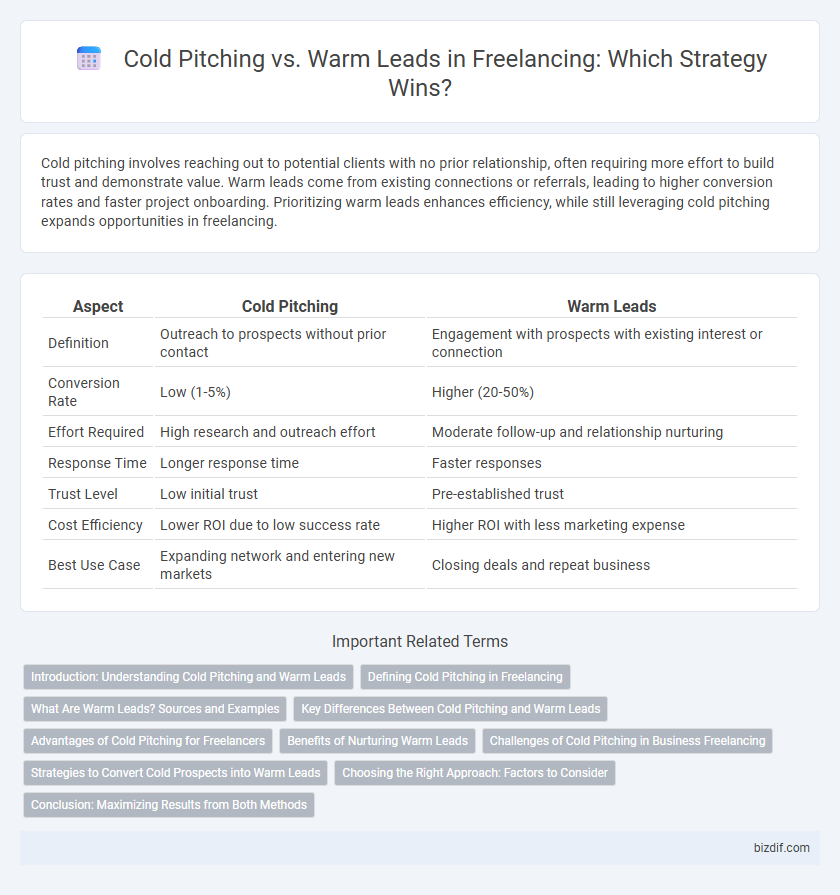Cold pitching involves reaching out to potential clients with no prior relationship, often requiring more effort to build trust and demonstrate value. Warm leads come from existing connections or referrals, leading to higher conversion rates and faster project onboarding. Prioritizing warm leads enhances efficiency, while still leveraging cold pitching expands opportunities in freelancing.
Table of Comparison
| Aspect | Cold Pitching | Warm Leads |
|---|---|---|
| Definition | Outreach to prospects without prior contact | Engagement with prospects with existing interest or connection |
| Conversion Rate | Low (1-5%) | Higher (20-50%) |
| Effort Required | High research and outreach effort | Moderate follow-up and relationship nurturing |
| Response Time | Longer response time | Faster responses |
| Trust Level | Low initial trust | Pre-established trust |
| Cost Efficiency | Lower ROI due to low success rate | Higher ROI with less marketing expense |
| Best Use Case | Expanding network and entering new markets | Closing deals and repeat business |
Introduction: Understanding Cold Pitching and Warm Leads
Cold pitching involves reaching out to potential clients without prior contact, relying heavily on persuasive messaging and strategic targeting to gain attention. Warm leads come from previous interactions, referrals, or ongoing relationships, offering a higher conversion rate due to established trust and familiarity. Efficient freelancing requires balancing cold pitching to expand client base while nurturing warm leads to sustain steady work and build long-term partnerships.
Defining Cold Pitching in Freelancing
Cold pitching in freelancing involves reaching out to potential clients who have had no prior interaction or relationship with the freelancer, often through unsolicited emails or messages. The goal is to introduce services directly and create interest without any previous engagement or referral. This method requires a clear, concise proposal tailored to the prospect's needs and demonstrates value to convert a cold lead into a paying client.
What Are Warm Leads? Sources and Examples
Warm leads are potential clients or customers who have already shown interest in your freelancing services through prior interactions, such as website visits, newsletter subscriptions, or social media engagement. Common sources of warm leads include referrals from existing clients, responses from email marketing campaigns, and inquiries from networking events. Examples of warm leads in freelancing are a contact who requests a project quote after a consultation call or followers who comment on your portfolio posts expressing interest.
Key Differences Between Cold Pitching and Warm Leads
Cold pitching involves reaching out to potential clients with whom you have no prior relationship, relying heavily on persuasive messaging to generate interest. Warm leads come from established connections or referrals, often resulting in higher conversion rates due to pre-existing trust and familiarity. The key differences lie in engagement levels, response rates, and the amount of personalized communication required to secure freelancing projects.
Advantages of Cold Pitching for Freelancers
Cold pitching allows freelancers to proactively reach a wider range of potential clients beyond their existing network, increasing opportunities for diverse projects. It enables freelancers to showcase their unique skills and tailor proposals directly to specific businesses or industries, enhancing personalized engagement. This method also helps build resilience and improve communication skills, essential for long-term freelancing success.
Benefits of Nurturing Warm Leads
Nurturing warm leads in freelancing significantly increases conversion rates by building trust and demonstrating expertise over time. Engaging with potential clients who have shown prior interest results in higher response rates and more consistent project opportunities. This approach reduces the effort spent on cold pitching and fosters long-term professional relationships that can lead to repeat business.
Challenges of Cold Pitching in Business Freelancing
Cold pitching in business freelancing faces significant challenges such as low response rates and difficulty in establishing trust without prior relationships. Freelancers often encounter skepticism from potential clients unfamiliar with their work, making it harder to showcase credibility through cold outreach alone. Overcoming these barriers requires persistent follow-up and highly personalized messaging to engage prospects effectively.
Strategies to Convert Cold Prospects into Warm Leads
Effective cold pitching strategies include personalized outreach that demonstrates clear understanding of a prospect's needs, leveraging social proof such as testimonials or case studies to build trust quickly. Following up consistently with valuable content or insights keeps prospects engaged and gradually nurtures the relationship toward a warm lead status. Utilizing platforms like LinkedIn for targeted connections and engaging in relevant industry discussions increases the likelihood of converting cold prospects into warm, actionable leads.
Choosing the Right Approach: Factors to Consider
Choosing between cold pitching and warm leads depends on factors such as industry niche, client relationship history, and response rates. Warm leads often offer higher conversion rates due to existing trust, while cold pitching can expand reach but requires personalized, value-driven messaging. Evaluating budget constraints, time investment, and the scalability of each method ensures a more strategic freelancing approach.
Conclusion: Maximizing Results from Both Methods
Combining cold pitching with warm leads enhances freelancing success by diversifying client acquisition strategies. Cold pitching opens opportunities with new clients through targeted outreach, while warm leads leverage existing relationships and referrals for higher conversion rates. Balancing both methods maximizes project inflow, optimizes networking, and drives sustainable freelance growth.
Cold pitching vs Warm leads Infographic

 bizdif.com
bizdif.com